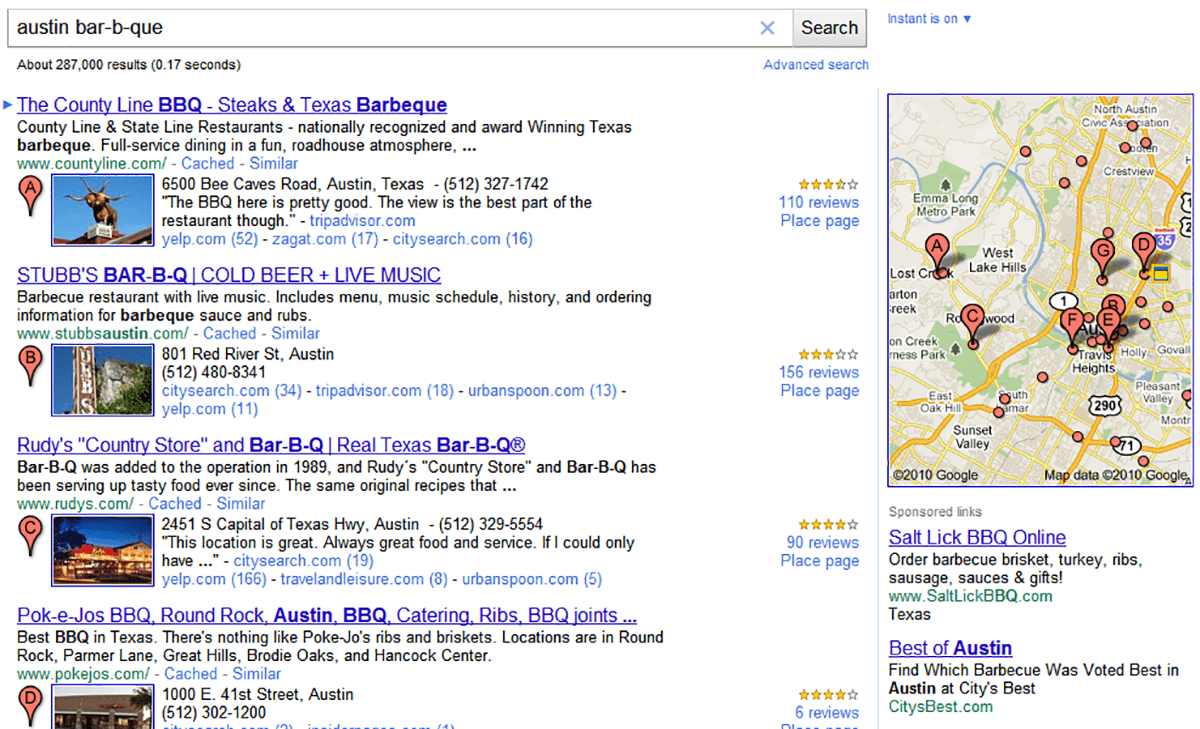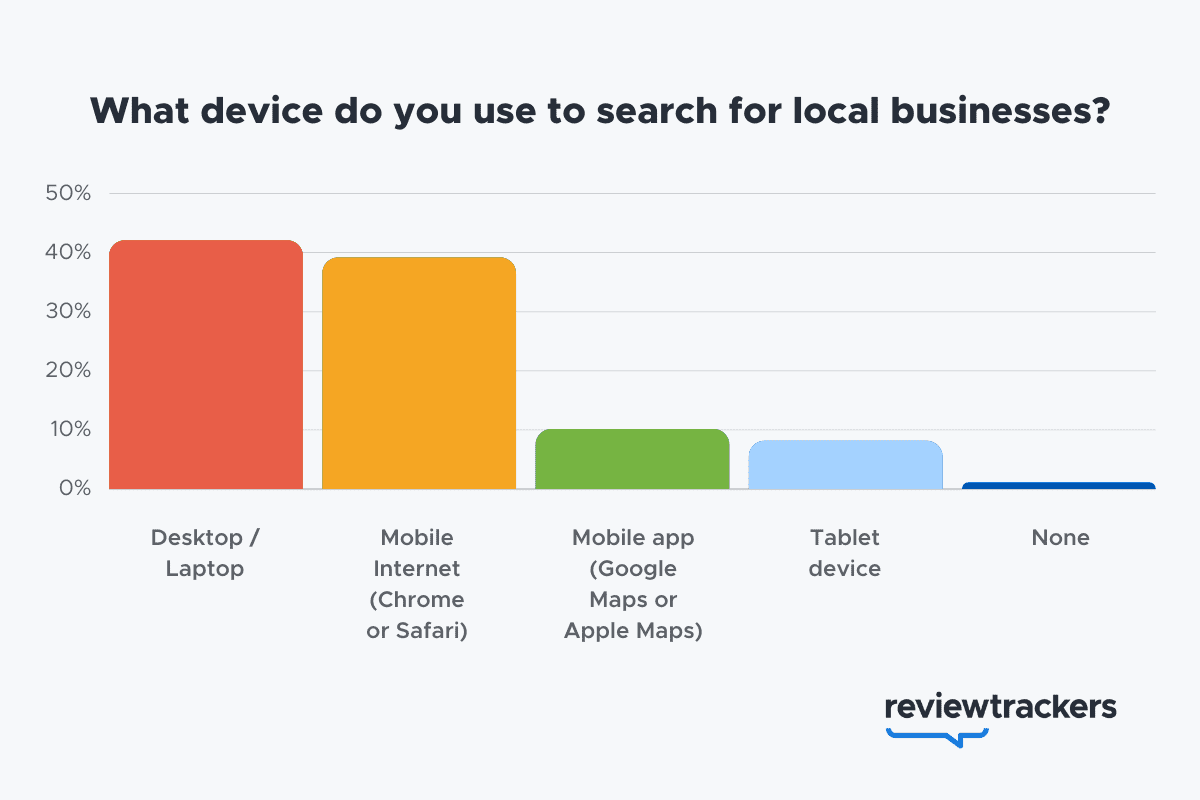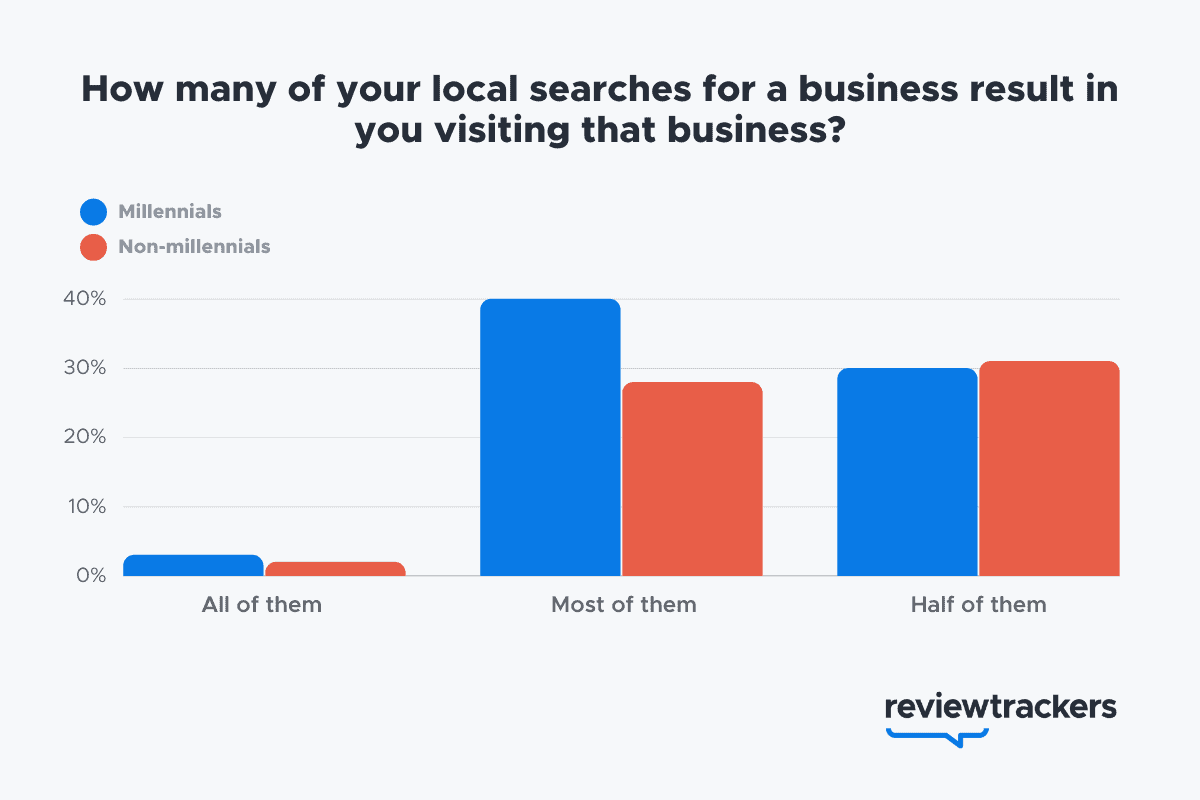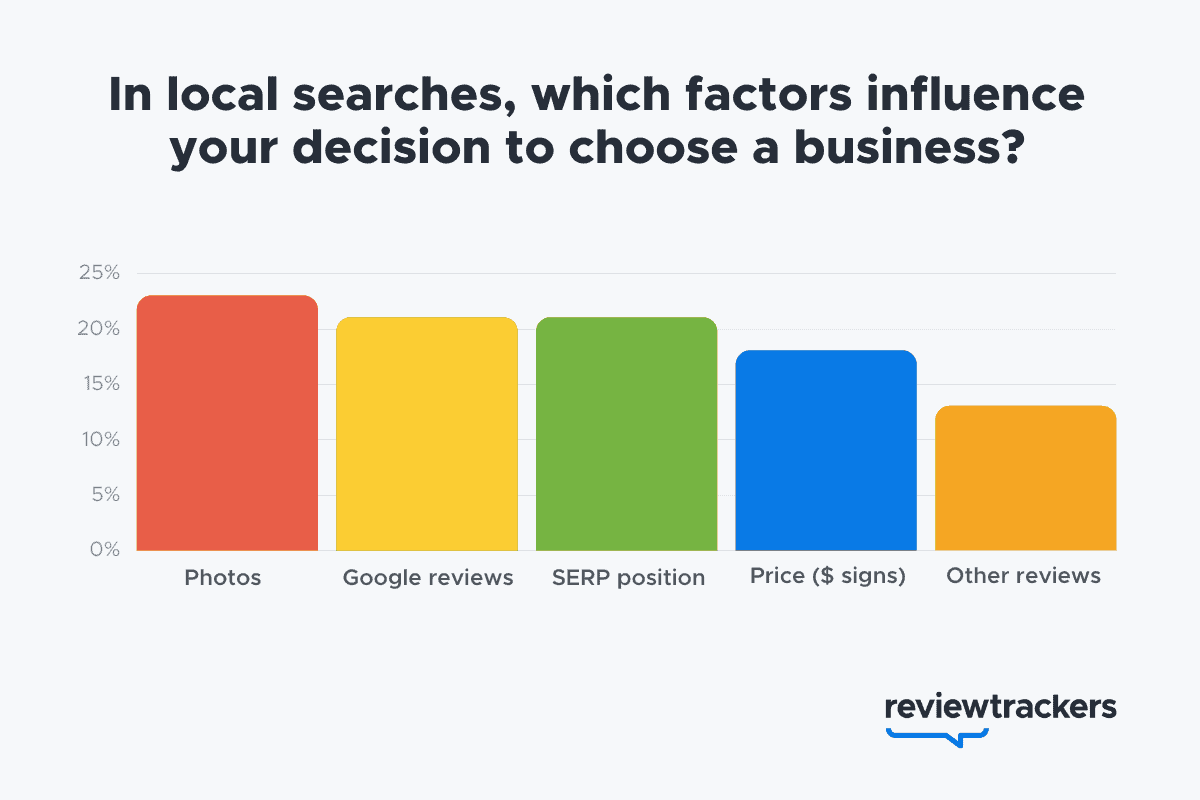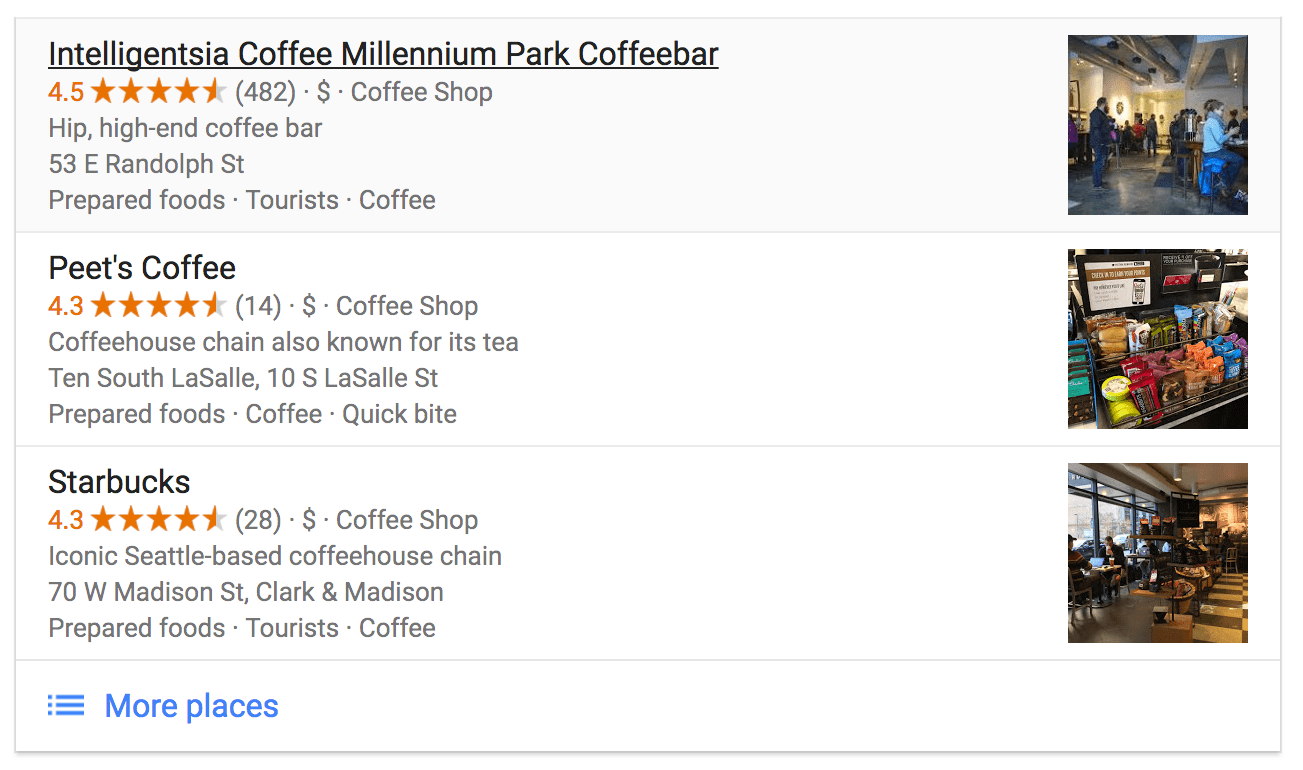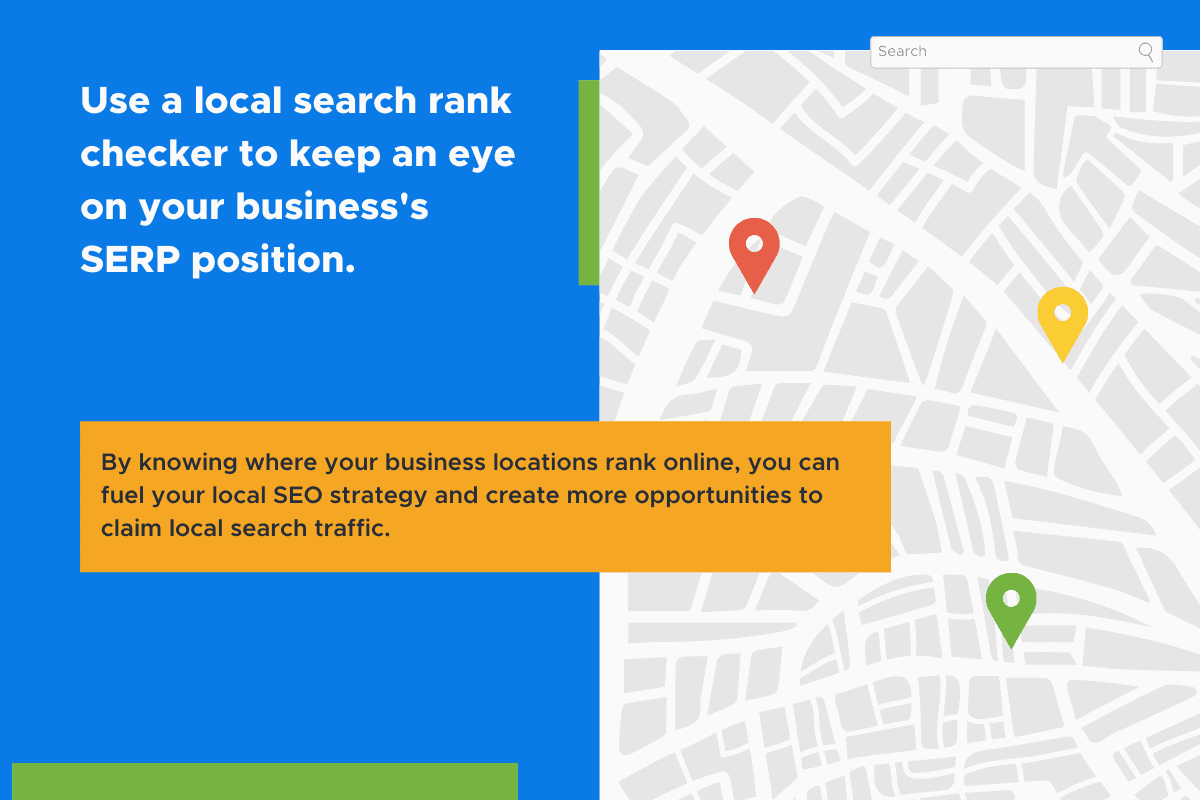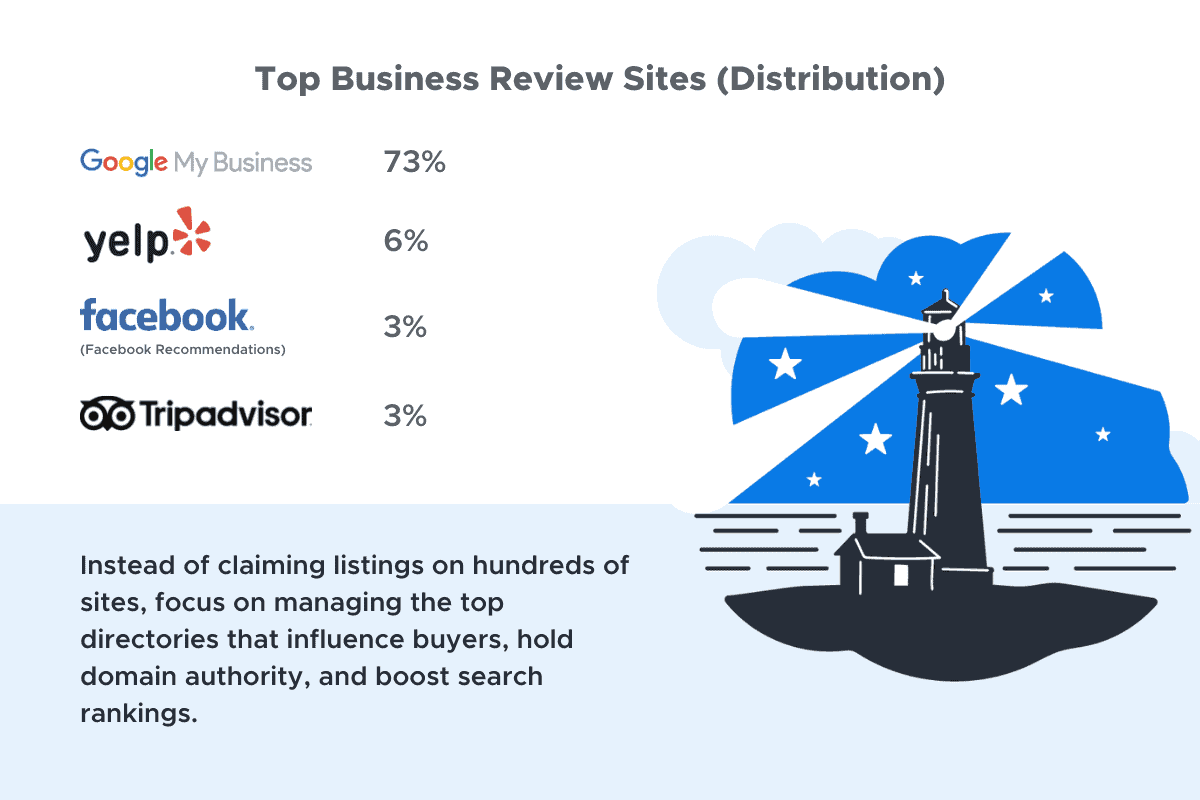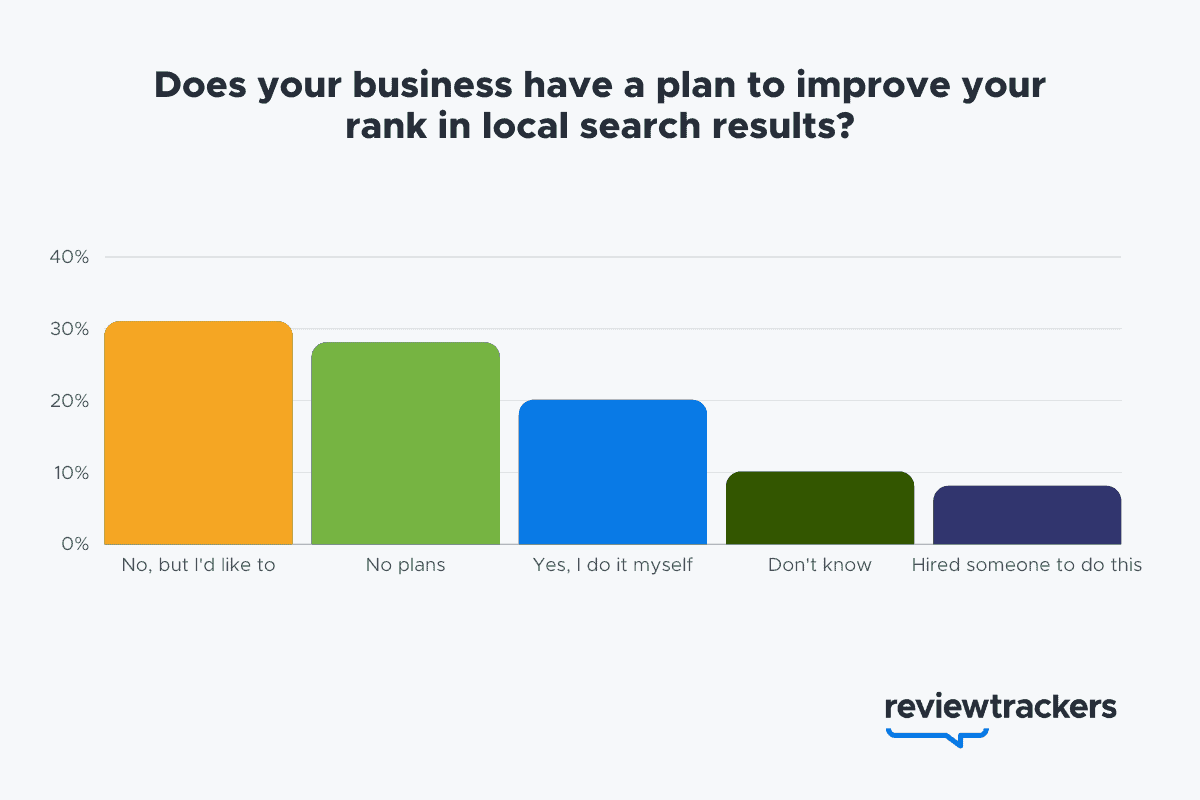These local SEO statistics and trends can help companies gain a more accurate view of the state of local search today — and how it reflects the constantly evolving ways that consumers find and discover businesses.
Here are some of our key findings and notable local search statistics:
- Most local searches are mobile. 57% of local search queries are submitted using a mobile device or tablet.
- Millennials speak the language of local search. They’re 50% more likely to use local search when they’re on the go — and twice as likely as other age groups to search for a business to visit immediately.
- Consumers look for specific trust signals in local search. The top 3 factors that influence their decision to choose a business are: photos, Google reviews, and position on the search engine results page (SERP).
- 88% of reviews come from only 4 review sites. The long tail doesn’t provide as valuable a return as it used to. Marketers should focus on top directories that hold domain authority and impact reputation.
- 58% of companies don’t optimize for local search. 31% would like to. But only 30% actually have a plan in place for capitalizing on this high-converting traffic.
Introduction: Local SEO Statistics and Trends
Back in 2010, search engine giant Google announced the launch of “Place Search.” It looked like this:
“Place Search” marked the auspicious beginning of what we now call local search. In just a little over a decade, local search has grown to become one of the most dominant principles of online marketing today.
Downloaded the report? How to Interpret Your Reputation Score
What is Local Search?
Local search is the use of search engines that allow users to submit geographically constrained search queries against a database of local business listings.
“Chicago restaurants.” “Sushi places in Brooklyn.” “Miami car dealer.” “Coworking space near me.” “Nail salons in SF.” “Beijing hotels.” “Bars in Bangkok.” “Cameras for sale in Manila.”
This is how people today search for information online about a certain product, service, or business. They want to find out where it is and what’s nearby — versus simply what it is — and are therefore constraining their searches to specific geographical locations.
More importantly, local searchers behave differently. They aren’t looking for general information. They’re looking for two kinds of actionable information about the businesses that show up in their search results:
- Listing information: store hours, phone numbers, address, menu, etc.
- Reputation information: online reviews and ratings, most popular keywords, whether a place is one of the “best” in the area, etc.
Google’s decision to show local search results back in 2010 was a bet that showing people local information would work because these searchers were going to behave differently.
This behavioral difference matters because there’s a lot of money riding on the issue. This means local SEO (local search engine optimization) is more crucial than ever. From a business perspective, it matters that local searchers are more likely to make a purchase and engage with a brand than the typical organic searcher.
Local SEO Statistics and Trends
In a two-part survey, ReviewTrackers asked a U.S.-based consumer panel about their local search habits: specifically, the ways they interact with local search information.
Our team also surveyed over 500 companies to ask how they are meeting the demand for local search and to see if they are implementing optimization and local listing management strategies in order to stand out in local search results.
This local SEO statistics and trends report aims to help digital marketers and executives enhance their local search presence and optimize it in ways that perform locally and reach the right audience.
Most Local Searches are Mobile
According to local SEO statistics, 57% of local search queries are submitted using a mobile device or tablet.
This shouldn’t come as a surprise. The first iPhone was launched in 2007. 14 years later, more than half of local searches are now mobile.
Local search users often turn to search engines like Google for want-to-know, want-to-go, want-to-do, want-to-buy moments. In these situations, they are increasingly picking up their phones and mobile devices for answers.
Another interesting finding from our study is that 89% of local searches are performed using a web browser. According to local SEO statistics, only 11% are done through a map-based app.
While map-based app searchers seem like a good idea, these haven’t really appeared on people’s radar. Online review website Yelp used to have a fun slot-machine feature that let the wheel of fate decide your next dinner. But in reality, local SEO statistics show that most local searches still take place within a browser window.
Millennials Speak the Language of Local Search
Millennials search locally to buy immediately. According to local SEO statistics, 42% of millennials who perform a local search will visit the business most of the time.
They are also 50% more likely to use local search when they’re on the go — and twice as likely as other age groups to search for a business to visit immediately.
This also shouldn’t come as a surprise. Millennials are used to using Google Maps to get directions, check star ratings and Google reviews, and make plans on the fly.
This can help us understand the importance of local search from a marketing perspective: local traffic is low-funnel traffic from key, ready-to-buy demographics. It also underlines one of the best cases for local search marketing and SEO: attracting millennials and their spending power.
Consumers Look for Specific Trust Signals in Local Search
When looking at local search results, there are a number of factors influencing consumers’ decisions about a business.
Here are the top 3:
- Photos: 24%
- Google reviews: 21%
- Position on the search engine results page (SERP): 21%
In the eyes of your potential customers, a search result with high-quality photos, positive reviews on Google, and a high ranking on local search engine results pages (SERPs) is more attractive than one that doesn’t have photos, has negative reviews, and has poor visibility on search.
Photos: According to local SEO statistics, local searchers like to look at nice pictures. They attribute a great deal of trust specifically to profile photos on local business listings.
When optimizing for local search, it’s easy for marketers to get so caught up in keyword analysis, content strategy, and link building that it’s easy to forget that for a local search result, having a high-quality profile photo may be the most effective way to improve click-through rates and lower bounce rates.
Consumers still like to look at nice pictures. When you’re focusing on local SEO, you can get so caught up in keyword analysis, content strategy, and link building that it’s easy to forget that for a localized search result (read: 33 percent of searches), having nice pictures may be the best thing you can do to improve click-through rates and lower bounce rates.
Google reviews: People rely on online reviews to validate their purchase decisions. According to online reviews statistics, searchers often apply rating filters because they don’t trust companies with lower than 4-star reviews.
A report also suggests that reviews are one of the top factors influencing organic local search results on Google — and a top 3 factor influencing which businesses are featured in the Google Maps Pack. More reviews also mean more information for search engine algorithms.
Google reviews are of particular importance: 63.6% of consumers say they are likely to check reviews on Google (through Google Maps and Search) before visiting a business location — more than other business review sites.
SERP Position: Local searchers attribute trust to businesses in higher positions on the first search results page. According to local SEO statistics, approximately 21% think that the position of the search result is one of the most important factors when they make a decision about a business.
This lines up with the way Google interprets local search intent. A high position on local SERPs means you’re a trusted local business. Google does its best to meet that expectation by showing top-rated businesses.
This highlights the importance of local listing management — of making sure that your business locations are accurately and consistently listed and updated on the top social media, online review sites, and business directories. (You may refer to this business directory list to get started.)
Local SEO software solutions typically include a local search rank checker to help companies keep an eye on their local search signals: specifically, the SERP position. By knowing exactly where your business locations rank online, you can fuel your local SEO strategy and create more opportunities to claim local search traffic.
88% of All Reviews Come from Only 4 Review Sites
Not only are online reviews crucial in shaping consumer behavior; they are also a major factor in determining local search results.
- Reviews can help your business rank higher in search results. In fact, they’re top 3 in the list of Local Pack / Finder ranking factors.
According to online reviews statistics and analysis by ReviewTrackers, only 4 sites are responsible for the distribution of 88% of all reviews. Google leads the way (73%), followed by Yelp (6%), Facebook (3%), and Tripadvisor (3%).
Moreover, roughly 75% of new business is influenced by only a handful of business review sites and directories: Google, Facebook, Yelp, Tripadvisor, Apple Maps, and Bing Maps.
By integrating online review management with your local SEO strategy, you can amplify local search signals for your brand and get closer to consumers who are looking for businesses nearby.
58% of Businesses Don’t Optimize for Local Search
Are businesses taking advantage of their local search opportunities? We surveyed companies about their local SEO strategy and this is what we found:
That’s right: over half of the respondents don’t optimize for local search.
Despite the fact that local search traffic converts really well, more than half of businesses aren’t optimizing for it. 31% would like to. But according to local SEO statistics, only 30% actually have a plan in place for capitalizing on this high-converting traffic.
As these local SEO statistics show, local search has continued to grow and younger generations (millennials) are showing a high conversation rate with local search. Simply put: higher local rankings increase in-store visits (traffic) and sales (revenue). For digital marketers and agencies, local SEO has to be a priority.
